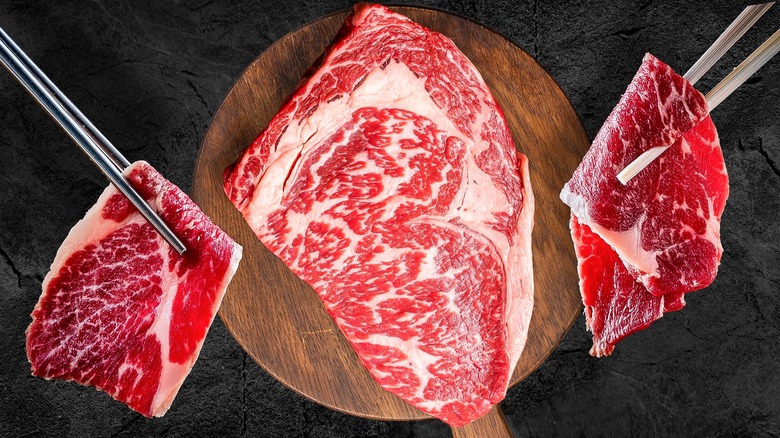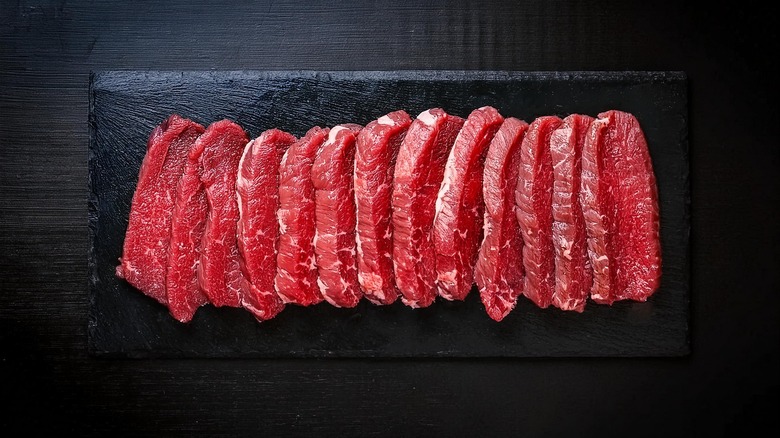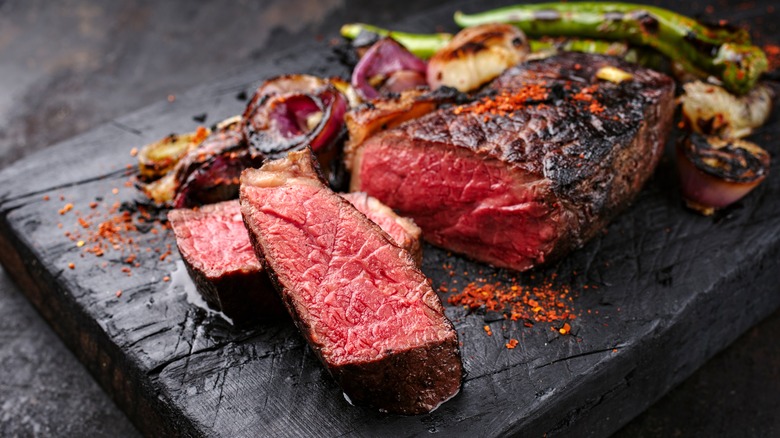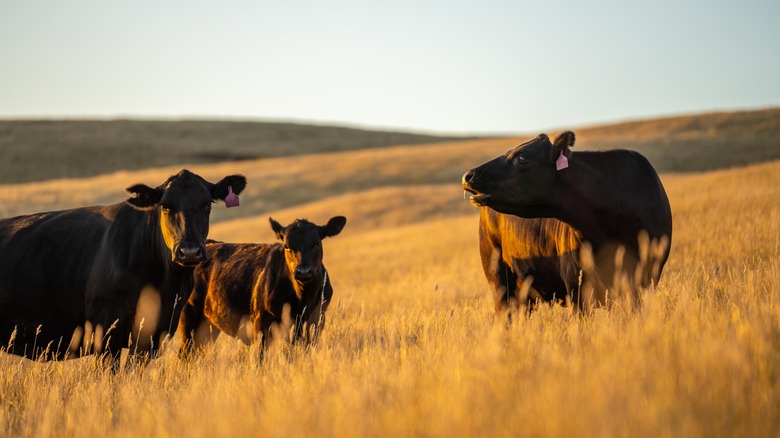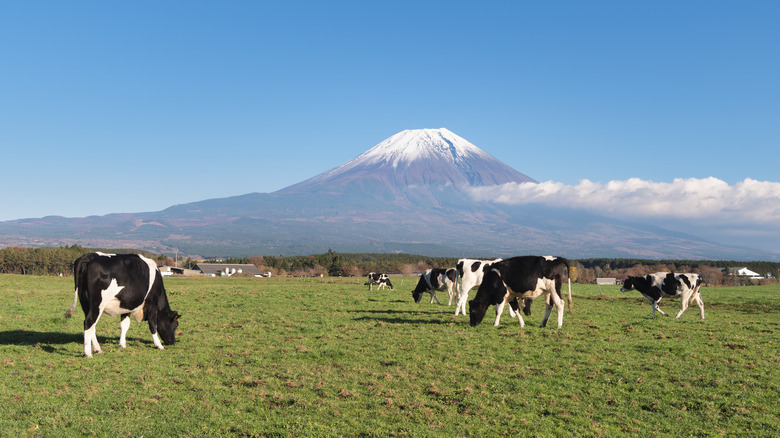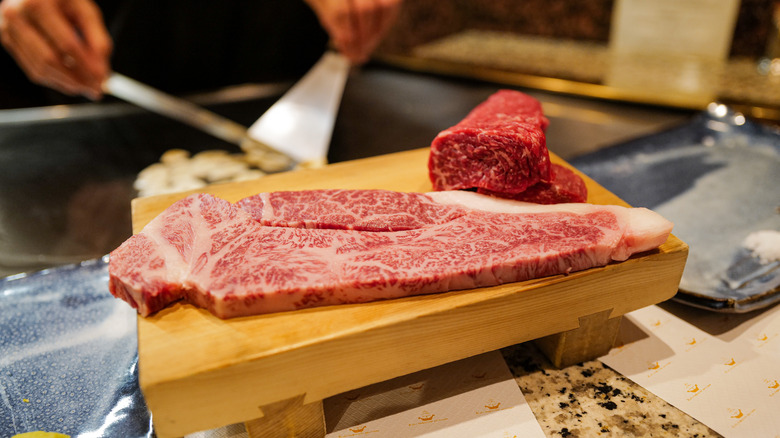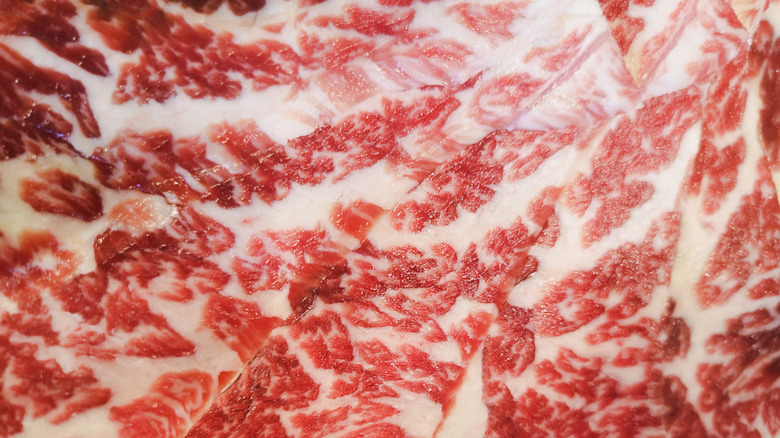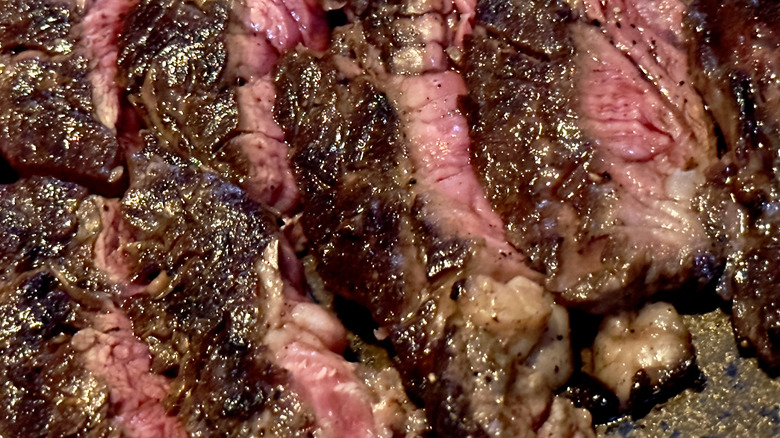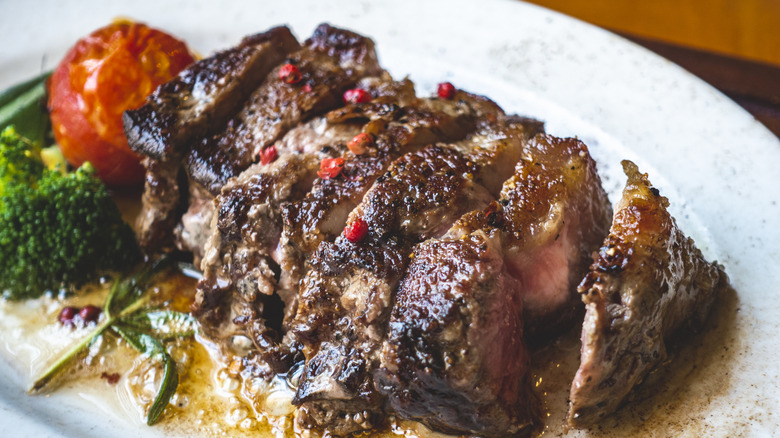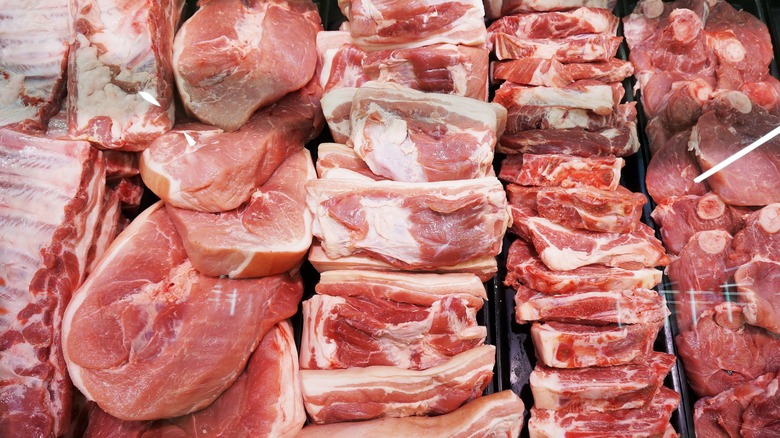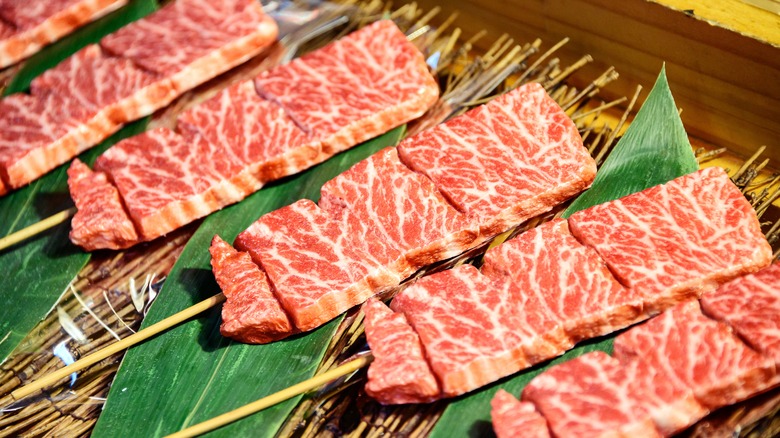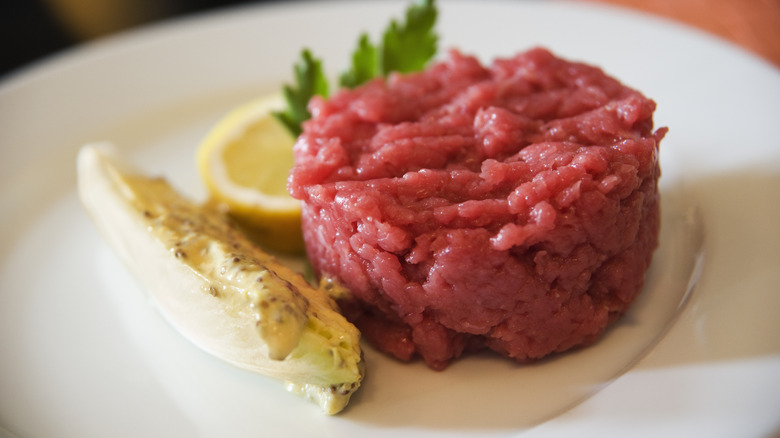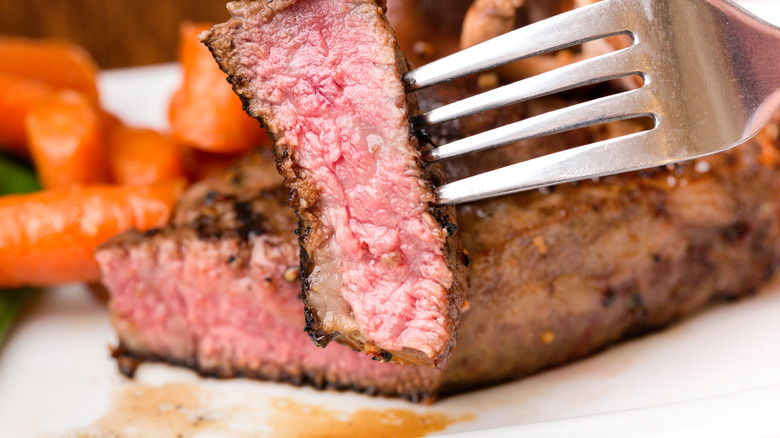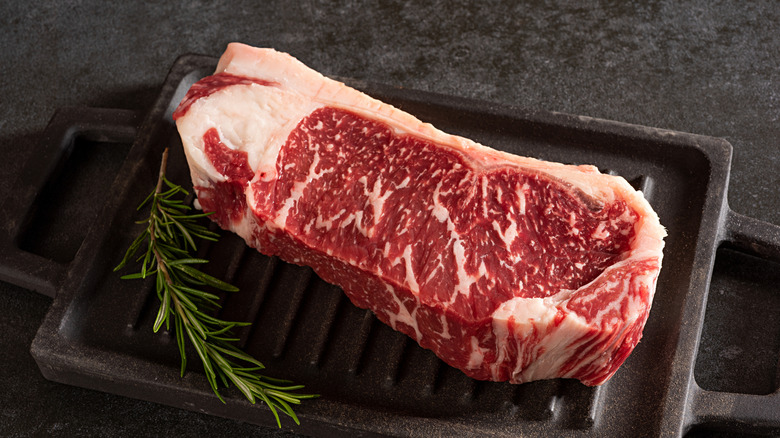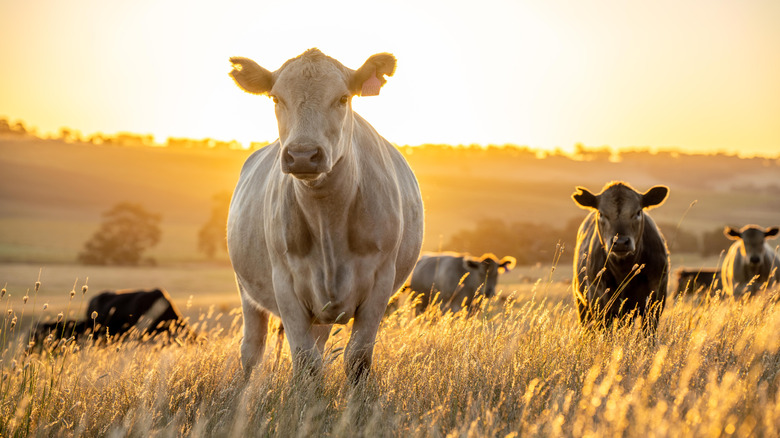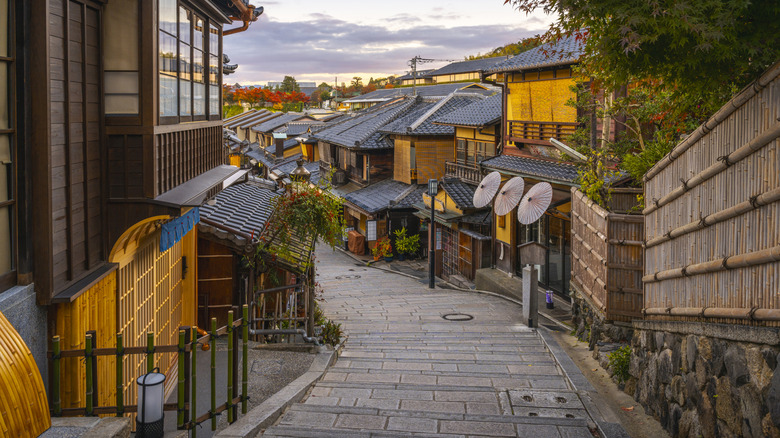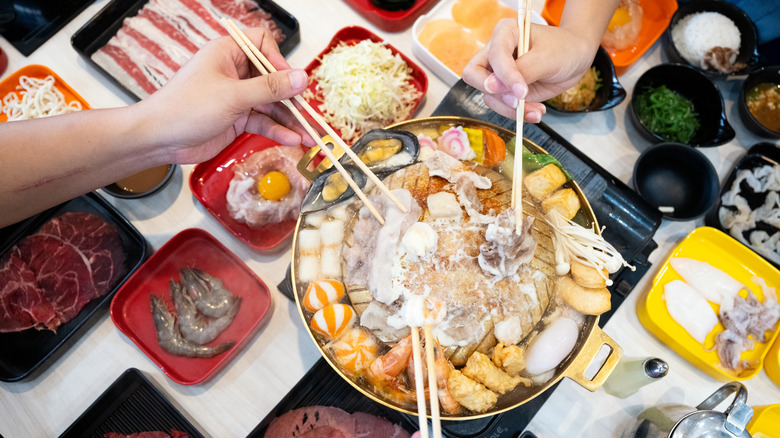Wagyu Beef: What It Is, What It Tastes Like, And Why It's So Expensive
If you've ever seen the term "Wagyu beef" on a menu, you've likely wondered what it means (and how the heck the restaurant is justifying that price). If you've ever experienced its tender melty goodness, however, you know exactly why you need to try it at least once in your life.
Of course, that's not all there is to know. Wagyu beef is a gourmet meat from farms that must adhere to strict feeding and rearing standards, with its highest grade, A5, meeting even higher quality requirements, making Wagyu cuts the most sought-after on high-end restaurant menus. Happily though, enthusiastic home chefs needn't wait for date night to eat Wagyu, as it's quite easy to obtain and cook at home.
To that end, Chowhound caught up with Nick Solares, brand ambassador for Pat LaFrieda Meat Purveyors. For the past 20 years, Solares has been a dedicated food writer with a specialty in Wagyu beef. His passion has taken him on extensive travels throughout Japan, including attending the prestigious Wagyu Olympics. Who better to educate us on what Wagyu beef is, why you should care, and how to get started with it at home. We also spoke with Shaun King, chef de cuisine at Uchiko Houston, who has a lot to say about this amazing beef.
What is Wagyu beef?
Although the name might sound impressive to an English-speaking audience, the name Wagyu is actually a simple translation to "Japanese cow." According to Solares, Wagyu "refers to any one of four breeds that include brown (sometimes referred to as red) and black hided animals, as well as a polled (hornless) and horned cattle." All of these breeds share an extremely desirable characteristic: a high degree of fat within the muscle, a.k.a. intramuscular fat or, to use the more popular culinary term, marbling.
It is important to note here that Wagyu isn't a cut, but rather a type of meat that also comes in grades, of which A5 is the most prized and must adhere to a strict quality control standard regulated by the Japanese government. To earn the A5 certification, the beef must come from cows that undergo elaborate rearing processes to ensure top-shelf attributes. As with any type of beef, you can buy various cuts of Wagyu, like top sirloin, ribeye, or short ribs.
Another important thing to know about Wagyu beef is that it refers to any of the above four strains of cattle from Japan, but these cows do not need to be raised in Japan. It can come from other countries, such as from Australia, though the rearing and certification processes will be different due to a different grading system. However, as long as cows are genetically from those lines, they may be officially termed Wagyu.
What does it taste like?
Wagyu beef has less of a flavor of its own and more of a signature texture. As Solares explains, "There is an evocation of beefiness but it does not have the steely minerality of dry-aged American beef or the herbaciousness of grass-fed steer. Rather it has a velvety lushness, a mouthfeel quite unlike leaner beef. Because of this richness, a little goes a long way."
If there's one flavor distinction to be found in Wagyu beef, though, it comes from the fat as well. The high levels of fat lead to a buttery umami flavor that's especially pronounced in Wagyu as compared to meat from other strains of cattle. As Solares points out, there's a lack of grassiness common among other types of beef, replaced by a sweetness that complements the strong umami flavor well. This doesn't stop it from being super-juicy, though, making it that all-around package. In dishes without a lot of other flavorings, where you really want the beef to come forward, this is an ideal trait.
What is the history of Wagyu beef?
"For all of its pedigree and legend Wagyu beef is not nearly as old as many Japanese traditions," Solares says. "In fact, the nation of Japan did not commonly consume beef until a decree from the Emperor in 1868, the same year Old Homestead steakhouse opened in NYC." Prior to this period, the Japanese had mostly avoided consuming beef as a dietary staple. Instead, cattle (primarily imported from Korea) were used as draft animals, and dinner plates across Japan featured mainly fish and vegetables.
At some point, other countries began to show interest in the strains developed in Japan. That is when American, Australian, and other producers started to import Wagyu cattle. Do note that although other countries can raise Wagyu cattle and sell the resulting beef (with notable price differences), this is a result of crossbreeding Wagyu strains with foreign ones, with the possibility of an attendant drop in quality ... or at least a change in flavor and texture.
That's not to say that Wagyu beef produced in other countries can't taste lovely and maintain that rich mouthfeel. It just means that the government standards are different, with many sources agreeing that the Japanese maintain higher ones. Therefore, if you want to get the most out of the information and cooking recommendations contained in the rest of this article, it is ideal to treat "Wagyu beef" as only that imported from the islands of Japan.
What do genetics have to do with it?
While the Japanese interest in consuming beef for food may not have begun until the 1800s, the genetics of this delicacy are long established. Indeed, Wagyu beef comes from a breed of Japanese cow whose lineage extends 35,000 years into the past. Once interest arose, however, it was quickly infused with characteristics from other genetic lines, including Brown Swiss, Shorthorn, Simmental, and Korean, among others. This gave birth to modern Wagyu beef.
In 1910, the Japanese government recognized the value of their stock and restricted further co-mingling of Wagyu genetics with outside lines, thereby preserving the four types of Wagyu cattle as heritage breeds. Between then and the 1990s, Japan exported cattle to many other countries for both food and breeding. In the '90s, however, they banned this practice. For that reason, Wagyu from Japan is now the purest form available.
"Through selective breeding, Wagyu cattle have been developed to exhibit specific traits," Solares says. He notes that, "Most obvious amongst these traits is the high degree of marbling the meat exhibits."
How is Wagyu beef produced?
Beyond breeding, Wagyu cattle are raised under a strict set of conditions. In order to maintain the superiority of their fat and ensure proper marbling, Wagyu cows receive detailed care compared to other cows on the market. Young cows are raised until roughly 10 months of age, then finished using a special fattening process that takes 2-3 years.
Wagyu cattle also consume different food to most other cattle. Whereas many cows are given grain only or grass-finished, or are grass-fed only in a free-range environment, Wagyu also receive rice. This, combined with hay and other grains and greens, helps to create the noteworthy marbling pattern and melt-in-your-mouth fat qualities.
As if that's not enough, Wagyu cattle are reportedly given beer or sake to make them hungrier, and are also raised in a low-stress environment. Together, the rich diet and purportedly chill lifestyle help to avoid the development of tough muscle fibers and maintain maximum succulence. Do note, however, that the Wagyu label does not necessarily mean that cows live a luxurious, humane existence. You should always check where your meat comes from to be sure animal treatment meets your standards.
Is Kobe beef related to Wagyu?
Because both names connote some of the fanciest possible cuts of beef on the market, folks may confuse Wagyu and Kobe beef, but the distinction is simple. Solares explains, "All Kobe is Wagyu, but not all Wagyu is Kobe." Kobe is a city in Japan's Hyogo Prefecture that produces the beef of the same name. Solares explains that while "Wagyu beef can come from any of the four main breeds, certified Kobe beef only comes from the black Tajima strain." He likens calling all Japanese beef Kobe to calling all sparkling French wine Champagne.
Given that its name simply translates to "Japanese cow," however, Wagyu beef may come from anywhere in the islands of Japan. For instance, as Solares points out, "we import Japanese Wagyu directly from a variety of prefectures such as Oita, Kumamoto, Yamagata, Nagano, Kyoto, Kagoshima, Iwate, and Hokkaido." The important point here is that Wagyu only becomes Kobe beef when it is actually reared and prepared in the city of Kobe.
What does marbling mean?
Marbling is, in itself, a simple term meaning fat veins that run through the muscle tissue of beef. However, when it comes to Wagyu beef, marbling is anything but simple, because it is so integral to the grading process set by the Japanese government.
"Japanese beef is graded for quality in a way similar to the way that US domestic beef is categorized by the US Department of Agriculture (USDA)," Solares says. "But while consumers in the US see beef broken down into three main classes (Prime, Select, and Choice based primarily on marbling) Japanese beef is graded using a far more complex system. This involves a matrix that assigns a letter grade for yield, with A being the highest of three classes, as well as a numeric quality grade that takes into account factors like marbling, color and brightness of flesh, the color, luster and quality of the fat, and overall firmness and texture." He explains that each category is assigned a score from 1 to 5, the latter being considered the highest grade.
Hence, A5 Wagyu earns the A from being beef of the highest yield, which means its cows give the biggest amount of saleable meat compared to their cousins of the same size. The 5 comes from having the best traits in each of the quality grades.
Is the fat different to regular beef fat?
Simply put, yes, the fat from Wagyu beef is different to the fat you'd find on a regular old cut of Whole Foods or Safeway steak, or even to what you'd find at the farmers market. Firstly, the amount of fat matters. Whereas most beef contains 12-13% fat, true Wagyu meat ranges from 30% to 50%. Cows that have been crossbred once, known as F1 cattle, typically have about 20% fat. The math doesn't lie: Wagyu beef is simply better-fatted than others, and due to its intense marbling, that fat is intramuscular rather than collared around the outside.
"But the nature of the fat itself is also important," Solares says. "The fat from the various Wagyu breeds has a very low melting point. It literally melts in your hand, let alone your mouth, giving it a unique taste and texture." Known as "sashi" in Japan, fat from Wagyu beef is also distinct from American or other types because it is primarily monounsaturated. That makes it lower in cholesterol, with traits similar to olive oil.
Why is it so expensive?
Broadly, Wagyu beef is expensive because there's a limited amount of it and it's held to extremely high standards, especially in Japan where it originated. Traits of the highest-quality meat extend well beyond the traditional pedigree of coming from one of Japan's four main cattle strains.
"'A5' is the highest grade given and only a small percentage of Wagyu cattle meet the criteria," Solares says. "Breeding is time-consuming and labor-intensive, contributing to the higher cost. Hence, there is a limited supply and it needs to be imported with strict regulations, transportation, and handling." Each step of the way, from careful breeding to gobs of paperwork certifying its origins, adds to the cost.
Even when you don't get your meat from Japan itself, but rather from cattle crossbred with it in other countries, the Japanese government is heavily involved in maintaining the name's association with peak quality. As such, no matter where you source it, you will find these factors hold true at least to some extent. Plus, with tariff rates that can exceed 26%, prices climb even higher as the beef enters the country.
Where should you source your Wagyu beef?
The best Wagyu beef still comes from Japan, period. Indeed, it's right there in the name, with the "wa" referring to its Japanese origin. In addition to sourcing Wagyu cuts through Pat LaFrieda, you can find true Japanese-reared Wagyu beef cuts from many other places on the market.
If you want to take the familiar approach and shop at your neighborhood grocery store, call their meat department and ask them if they can source the cuts you want. Many of them will happily do so, provided they already stock a number of specialty items and have the right connections. They will usually cut and truss the meat for you as well. If, on the other hand, they don't, they may be able to direct you to a purveyor that will serve your needs.
On the other hand, many chefs enjoy home delivery of ingredients such as Wagyu beef. These cater to foodies who want certified high-ticket items of a very exacting nature. Just make sure you do your due diligence on the provenance of their meat as well as the standards they maintain during delivery. No one wants to come home to warm beef.
What should you know when buying it?
Unfortunately, a lot of the meat labeled as Wagyu on the market is not genuine. While American breeds of Wagyu can genuinely earn the title by following standards closely aligned with Japanese government specifications, beef labeled Wagyu is not necessarily legitimate. Not only is it a good idea to check out who produced the beef, you should also look for Wagyu traits. The beef should be so well-marbled that it is pink rather than red, for one thing. For another, it should be boneless. Ask the butcher which prefecture it comes from; if they can't tell you, look elsewhere.
Also, says Solares, adjust your expectations of amount accordingly. "Whereas 16 ounces is a normal amount for a Western-style steak, Wagyu portions should be closer to 4-6 ounces," he explains. That's good news in the sense that it helps make up for the high cost of Wagyu beef, which runs around $80 for 4 ounces.
What is Wagyu beef best for?
One of Wagyu's nicest traits, Solares says, is that it can be used as either an appetizer or for your main meal, and home chefs have many options when it comes to the specifics. For instance, it's a delicious beef cut for a charcuterie board. You can also make Wagyu beef tartare, though note that due to its high fat content, you will not be able to eat as much before you hit that richness overload.
Different cuts of Wagyu are good for different styles of cooking. For instance, a ribeye makes for a great medium-rare steak, whereas a tomahawk (a large ribeye with a trimmed bone) works well first seared and then oven-roasted. Short ribs, as always, want the low-and-slow treatment.
The best temperature to cook Wagyu steak will vary depending on the cut of meat and how you are preparing it. No matter what, cautions Solares, "Be wary of undercooking. A5 grade Wagyu is best served medium rare. Because of the high level of marbling, you want to make sure you are rendering it correctly." In other words, don't go too rare (e.g. the black-and-blue treatment, which is still essentially raw on the inside), or you won't get to enjoy the melt-in-your-mouth goodness that comes from the fat. Naturally, if you are serving it tartare, this obviously doesn't apply.
What mistakes do people make with Wagyu beef?
Again, undercooking will fail to render the fat that makes this beef taste so tender. Overcooking, however, will render the fat too much so that it runs out of the meat and ruin its texture. For that reason, experts suggest you only cook Wagyu rare or medium rare. This is enough to melt the fat and baste the meat with its own juices, but not enough to overshoot. For rare, opt for an internal temperature of 125 F, and for medium-rare, go for 135 F.
Due to the dangers of overcooking, you probably want to avoid grilling Wagyu steak, at least while you're getting to know its qualities. Its high fat content means it will drip incessantly, causing flareups that can brown the outside of the meat too much while waiting for the inside to come to the right temp. At least at first, pan-frying is probably the better option, because you can control the amount of heat better and there's no drip effect.
How can home cooks get started with Wagyu?
The best way to get started with Wagyu is to head to a restaurant and experience it for yourself. That way, you'll know if you like it, and you can also get ideas for how to prepare it. From appetizers to main courses, Wagyu is a versatile food, and it can help you overcome some of the apprehension of a highly expensive new ingredient by tasting it first.
From there, it's a matter of sourcing good, high-quality meat from a reputable supplier. For the absolute best experience, look for Wagyu beef that was raised and butchered on the islands of Japan. It should be authenticated by the Japanese government as having earned the A5 rating, which according to purveyor Pat LaFrieda "represents the zenith of marbling, texture, and flavor, ensuring that each bite delivers a symphony of rich, buttery flavors and a tenderness that dissolves on the palate."
If you are afraid to cook expensive meat at home, take a deep breath and do a little research. Beef isn't that difficult to cook, happily, but you may need to refresh yourself on storage techniques, temperatures and times, and seasonings. Find a recipe that's specifically dedicated to Wagyu so that you can get the most out of its delicate flavor, and remember to relax and enjoy!
The Wagyu Olympics
"The Wagyu Olympics was launched in 1966 to help encourage a high level of cattle breeding, tourism, and to promote Wagyu beef in and out of the country," explains Shaun King, chef de cuisine at Uchiko Houston (which just sent a few of their chefs to Japan for Kobe certification). "The competition takes place every five years and awards cattle farmers with the designation of the best beef in the world."
There are two main categories: breed improvement and meat quality. The first rates cattle by their external characteristics. As you might see at any dog show, judges look for impressive size, good proportions, and other standards. The second rates meat on those traits unique to Wagyu, such as good marbling. Those whose cattle perform well see an economic advantage: They're able to sell both meat and cows to the best eateries and butcher shops at a higher price than others in their category.
Why is Wagyu designated a national treasure?
"The breeding of Wagyu beef in Japan is highly regulated," Shaun King, chef at Uchiko Houston, says. "Progeny testing is mandatory. Only the very best proven genetics are kept for breeding." Who decides what constitutes the very best genetics, then? Zenwa, Japan's oversight and regulatory body for all four Wagyu breeds. "After the genetics of only 221 Wagyu were exported from Japan — realizing the value of their unique product — the Japanese government banned the export of Wagyu in the late 1990's and declared Wagyu a national treasure."
Recognition that Wagyu breeds truly are a national treasure in Japan, the government changed its export status. It is now illegal to export live animals; only the meat may be sold overseas. The upshot is that only Japan has the ability to breed new strains from the existing Wagyu cattle, if they wish, though some other countries do have access to some Wagyu genetics from previous exports.
What drinks and sides does Wagyu pair well with?
In general, Wagyu is pretty delicious, so if you get a chance to try it, you shouldn't worry too much about what it's paired with. That said, there's nothing wrong with trying to create a premium experience. Choosing the right drinks and sides will help you do just that.
As for drinks, Uchiko Houston's Shaun King advises strong flavors. Whiskey and high-proof drinks both work well. Cocktails made from A5 Wagyu fat-washed bourbon are growing in popularity as well. Fat-washed bourbon is made by rendering Wagyu fat and putting it in a pot over low heat along with bourbon. The process helps to infuse the liquor without boiling it off and losing its potency. After an hours-long infusion process, chefs put the whole batch in the fridge, where the fat rises to the top and can be removed. The bourbon now has a rich, nutty, lovely taste that naturally pairs quite well with Wagyu.
As for sides? Go for "simple-flavored, high-salinity foods such as French fries or chips," King says. These are the best ones to satisfy your need for some carbs without detracting from Wagyu's peerless flavor, which should always be the star of the show.
What are the best Japanese ways of preparing Wagyu?
It stands to reason that, what with taking pride in Wagyu's flavor and quality as it does, Japan would have developed some super tasty ways of eating its prized meat. The most popular and delicious of these are, according to Shaun King, chef de cuisine at Uchiko Houston, Yakuniku, robata, shabu shabu, katsu fried, and sushi.
There are different approaches to sushi, but they usually focus on Wagyu as the star. For instance, it's common to use it as nigiri, giving it a light sear right before serving. Which dish you choose depends on the cut, King adds. For instance, Wagyu nigiri is delicious made with short rib block. Katsu-fried Wagyu beef is also popular, giving the meat a crunchy coating while keeping the inside quite rare. These two styles of preparation are the ones most likely to be familiar to your average American eater.
Shabu shabu (which you may also see as shabushabu or shabu-shabu), is a hotpot dish. Guests sit around and cook pieces of meat and veggies in a communally located pot of hot broth, and Wagyu is a lovely treat to add to the meal. It not only tastes delicious, it leaves a nice flavor in the broth as well. Yakuniku (essentially Japanese barbecue) and robatayaki or robata (slow-grilled skewers) are popular as well.
